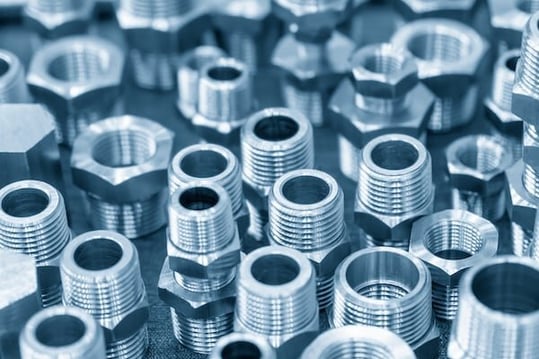Hydraulic fittings join hoses, pipes, manifolds and tubes in a hydraulic system. The male and female fittings, ports or pipe ends combine to make a connection. When properly fitted, these connections serve to allow an uninterruptible flow of hydraulic fluid while maintaining adequate system pressure. Engineers and maintenance personnel can maintain flow velocity, alter flow direction, line elevation and split flow using various fittings.
When determining the connection's threads, pay close attention to the thread style. For instance, an NPT fitting with a 60° angle may look similar to a BSP with a 55° angle, yet they are not compatible. Always ensure the thread styles are a match before making a connection. When in doubt, use a thread gauge to ensure the correct angle, pitch and diameter. 
Hose Assembly
Hose assembly can be made after choosing the appropriate connections and hose. You can create three different assemblies, such as permanent crimped, permanent swage and "field attachable." There are different parts, tools and processes for each assembly method, however the measuring, cutting and fitting orientation methods are all the same.
Hose Measuring
For practical installation, many assemblies require the length to fall within a narrow tolerance. This is especially true for assemblies of short, high-pressure hoses. Understanding the distinction between hose cut length and total assembly length is crucial.
Crimping the Hose to the Fitting
The most typical technique for connecting hoses and fittings is crimping. Once the crimp specifications for the particular hose and fitting have been verified, a crimping machine is configured to the proper crimp diameter setting. The fitting must be greased before being attached to the hose's end and placed in the crimping device.
A hydraulic crimper is a tool used to make a permanent connection of a hydraulic hose to a hose fitting. They are usually hand-hydraulic or remote-hydraulic crimp tools. The hose crimper uses a 360 degree force on the outside of the fitting collar which creates a tight grip on the hose, securing it to fit the fitting nipple inside the hose. This secures the fitting to the hose to keep the assembly secure under pressure.
Using a crimp machine to assemble the hose and fitting:
- Measure and cut the hose to the designated length, making sure the cut is perpendicular to the hose.
- Make a chalk mark on the hose to indicate the insertion depth of the fitting to designate the proper seating on the hose.
- Ensure the hose is clean of any debris to reduce chances of contamination post-assembly.
- Select the correct die and crimp diameter for the assembly.
- Push the hose through the die and into the crimping machine so the fitting is directly above or outside of the die.
- Turn on the machine to allow the cylinder head to move down compressing the collar in the die. The machine will automatically stop when the collar bottoms out on the die.
- Ensure the fitting end is aligned with the chalk mark on the hose (see step #2).
Finally, it’s best practice to cap the assembly at both ends to avoid contamination during storage or shipping. Keep in mind crimp machines from different manufacturers may vary, so be sure to read the user manual prior to use.
The proper hose assembly and crimping technique simplifies the connection of hydraulic fittings. But no matter what you are connecting make sure all components are compatible. And always inspect your hoses and fittings for a secure leak free connection.
For more information on hydraulic system safety, visit 4 Considerations for Safe Hydraulic System Maintenance or download the PDF.

Sources:
Hose Assembly Tips
